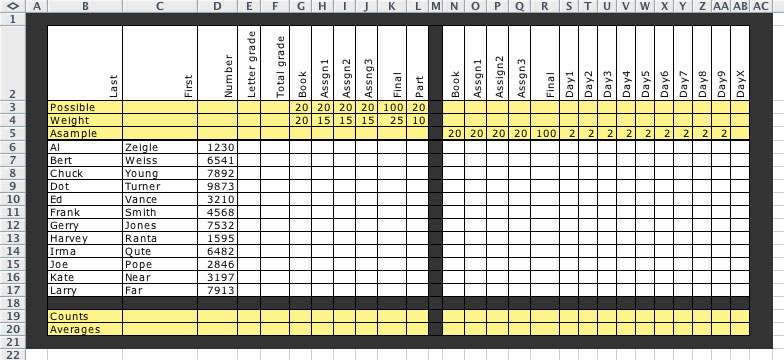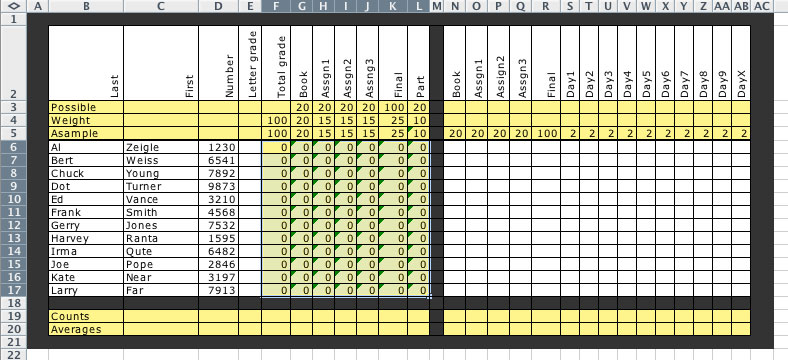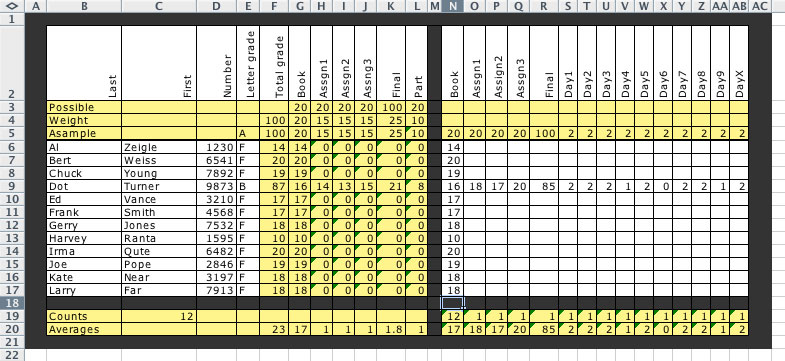CSE610 - Day 3 - Excel - Gradebook Description
Gradebook with Weighted Grades - Using Excel
- What assignments, homework, tests, projects will be included in the gradebook
- What weight or percentage of the total final grade will each assignment or entry be given; for example, if the final test will be worth 25% of the total course grade, the weight would be 25
- What is the maximum points that will be given to each assignment; for example the final will be graded on the basis of 100 points, hence the maximum is 100, whereas the book review may be graded on the basis of 20, so the maximum would be 20
- What is the range for each letter grade; for example 90-100 is an "A", 80-89 is an "B", etc.
Let's consider the following model. The gradebook will include grades for the final test, a book review, three assignments and participation in ten class periods.
The final will be worth 25%, the book review 20%, each assignment 15% and each day of participation 1% for a total of 100%. (This must add to 100%.)
The final test will be graded on a maximum of 100 points, the book review and each assignments can receive up to 20 points and the daily will be graded on the basis of 2 points (good participation, some participation and poor participation).
We'll let 90's be "A", 80's "B", 70's "C", 60's "D" and below 60's "F".
- Blank
- Last name of the student
- First name
- Assigned student number, i.e. the last four digits of the V-number at WOU
- Letter grade
- Total class score
- Book review weighted score
- Assignment one weighted score
- Assignment two weighted score
- Assignment three weighted score
- Final test weighted score
- Total participation weighted score
- Blank
- Actual book review score
- Actual assignment one score
- Actual assignment two score
- Actual assignment three score
- Actual final test score
- -28. Daily participation actual scores
- Blank
- Headings or titles of each column
- The maximum possible points for each assignment
- The weight of each assignment
- A sample "ideal student" (for testing the computations)
- A row for each student
- A blank row after all the students
- A row for counting the assignments
- A row for averaging grades
I typically color the borders and blanks rows and columns a different color so I can quickly focus in on the grades. I also color the second through five rows another color for the same reason as well as columns that I want to "jump" out at me for quick reference.
- Enter students' names and numbers as appropriate in columns B-D in rows 6 through whatever (for this assignment enter about ten fictitious names).
- Enter the appropriate headings or titles for each column in row 2.
- Enter the maximum possible points for each assignment in row 3 and the weights in row 4
- Name the sample student Asample and enter perfect scores for this student in columns N through AB.
- Select (highlight) cells and use Format/Cells to add color and align text. Highlight a column (by clicking on the letter at the top of the column) and use Format / Columns to change its width.

- In cell G5 (that's the
first weighted score for our sample student, if you choose a different
layout and don't end up in G5), enter the formula =N5/G$3*G$4 . What is happening is you're dividing the student's score (in
cell N5) by the maximum possible score (in cell G3) giving you
the percentage score for that student's assignment and then multiplying
it by the weight given to that assignment (which is in cell G4). Why the dollar signs? In a moment we are going to quickly
and easier replicate that formula to all students and while the
N5 will reflect the particular student's score by changing to
N6, and N7, and so on, the G3 and G4 cell must remain absolute.
The dollar sign does that.
- After pressing Return or
Enter, click on that same cell again. Notice as you drag your
cursor to different parts of the cell, three different cursors
appear. The hand will allow to drag the contents of that cell
somewhere else. Don't do that. The big plus is the primary cursor,
but the third (its shape varies from computer to computer) appears
when you near the lower right corner of the cell. When it appears, click and drag to the right over the cells for the three
Assignments and the Final. Release the mouse. Notice that the
same formula is now in all the cells.
- In the Participation cell,
which we just ignored, type =sum(S5:AB5)/L$3*L$4 and press
Enter or Return.
- In cell F5 type =sum(G5:L5) and press Return/Enter. This should be 100.
- In cell F4 type =sum(G4:L4) and press Return/Enter. You could highlight F5 and copy and paste
it into F4. This should also be 100.
- Click and drag your cursor across F5 to L5. Release. Move to the special cursor in the lower right corner of L5. Click and drag that cursor down over all the rows of students. Release. Now the formulas are in all the cells.
Before we do the hard part, you should be seeing something like this. That dragging may have messed up some formatting so you have to clean that up.

- In cell E5 (that's just
to the left of the F4 where we put the total class score several
steps earlier), enter the formula =IF(F5<90,IF(F5<80,IF(F5<70,IF(F5<60,"F","D"),"C"),"B"),"A") . Click and drag this cell to replicate this formula for all the
students.
- Highlight the cell in the
Counts row in the First Name column. The top menu bar, select
Insert and then Function. When the new little window appears,
select All in the left column and COUNTA in the right column.
When the next window appears, click on the little triangle to
the right of the first textbox; and then highlight all the first
names. Click on that same little triangle and click OK.
- Repeat the above process
in the Counts row in the columns where you will be entering the
scores using the COUNT function. COUNTA counts words, COUNT
counts numbers.
- Repeat the above process in the Averages row in the appropriate columns using the AVERAGE function. Until you enter scores this may look crazy.
The sample below includes some scores for one completed assignment and all scores for one student so one might see how this works.

Save in public_html (P:drive) after it is complete. Also save on your desktop and upload into Moodle.
- Highlight the entire rows of all
the students by clicking on the number in front of the first row
with student information and dragging down to the last row with
student information. In this sample that would be 6-17. Be certain
that the entire row is highlighted and not just a couple columns.
- Select Data, then Sort from the
menu bar. Sort on the column with the students' numbers (probably
column D).
- Highlight all the students' scores including the headings but certainly not the names. In this example
that would be from cell D2 to AB17. Notice that counts and averages
were not selected as you may not want to share that information.
- Select File and then Save as Web Page in the menu bar. Save in your public_html folder and give it an
appropriate name making certain that the .htm or .html is on the
end of the name.
- Check your work online by going to your webpages at www.wou.edu/~username.
